Tertiary education, also referred to as third-level, third-stage or post-secondary education, is the educational level following the completion of secondary education. The World Bank, for example, defines tertiary education as including universities as well as trade schools and colleges.[1] Higher education is taken to include undergraduate and postgraduate education, while vocational education beyond secondary education is known as further education in the United Kingdom, or included under the category of continuing education in the United States.


Tertiary education generally culminates in the receipt of certificates, diplomas, or academic degrees. Higher education represents levels 5, 6, 7, and 8 of the 2011 version of the International Standard Classification of Education structure. Tertiary education at a nondegree level is sometimes referred to as further education or continuing education as distinct from higher education.
UNESCO stated that tertiary education focuses on learning endeavors in specialized fields. It includes academic and higher vocational education.[2]
The World Bank's 2019 World Development Report on the future of work[3] argues that given the future of work and the increasing role of technology in value chains, tertiary education becomes even more relevant for workers to compete in the labor market.
Definition

Higher education, also called post-secondary education, third-level or tertiary education, is an optional final stage of formal learning that occurs after completion of secondary education. This consists of universities, colleges and polytechnics that offer formal degrees beyond high school or secondary school education.
The International Standard Classification of Education in 1997 initially classified all tertiary education together in the 1997 version of its schema. They were referred to as level 5 and doctoral studies at level 6. In 2011, this was refined and expanded in the 2011 version of the structure. Higher education at undergraduate level, masters and doctoral level became levels 6, 7, and 8. Nondegree level tertiary education, sometimes referred to as further education or continuing education was reordered as level 4, with level 5 for some higher courses.[4]
In the days when few pupils progressed beyond primary education or basic education, the term "higher education" was often used to refer to secondary education, which can create some confusion.[note 1] This is the origin of the term high school for various schools for children between the ages of 14 and 18 (United States) or 11 and 18 (United Kingdom and Australia).[5]
Global progress
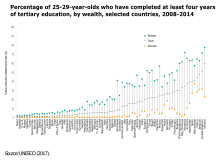
Globally, the gross enrollment ratio in tertiary education increased from 19% in 2000 to 38% in 2017, with the female enrollment ratio exceeding the male ratio by 4 percentage points.[6]
The tertiary gross enrollment ratio ranges from 9% in low-income countries to 77% in high-income countries, where, after rapid growth in the 2000s, reached a plateau in the 2010s.[6]
Between now and 2030, the biggest increase in tertiary enrollment ratios is expected in middle-income countries, where it will reach 52%. Sustainable Development Goal 4 (SDG 4) commits countries to providing lifelong learning opportunities for all, including tertiary education.[6]
This commitment is monitored through the global indicator for target 4.3 in the sustainable development goal 4 (SDG 4), which measures the participation rate of youth and adults in formal and non-formal education and training in the previous 12 months, whether for work or non-work purposes.[6]
The right of access to higher education
The right of access to higher education is mentioned in a number of international human rights instruments. The UN International Covenant on Economic, Social and Cultural Rights of 1966 declares, in Article 13, that "higher education shall be made equally accessible to all, on the basis of capacity, by every appropriate means, and in particular by the progressive introduction of free education".[7] In Europe, Article 2 of the First Protocol to the European Convention on Human Rights, adopted in 1950, obliges all signatory parties to guarantee the right to education.[8]
Criticism
In 1994, the UNESCO Salamanca Statement called on the international community to endorse the approach of inclusive education, including at the tertiary level. Since this time the world has witnessed the global massification of tertiary education, yet this explosion of facilities and enrollment has largely entrenched and exacerbated the exclusion of people with disabilities. This is particularly the case in low- and middle-income contexts, where university completion rates for students with disabilities are much lower compared to completion rates of students without disabilities.[9]
Some tertiary schools have been criticized as having permitted or actively encouraged grade inflation.[10][11] In addition, certain scholars contend that the supply of graduates in some fields of study is exceeding the demand for their skills, aggravating graduate unemployment, underemployment and credentialism.[12][13]
Influence on views
Graduates of tertiary education are likely to have different worldviews and moral values than non-graduates. Research indicates that graduates are more likely to have libertarian principles with less adherence to social hierarchies. Graduates are also more likely to embrace cultural and ethnic diversity and express more positive views towards minority groups. For international relationships, graduates are more likely to favor openness, supporting policies like free trade, open borders, the European Union, and more liberal policies regarding international migration.[14]
Providers

In the U.S., higher education is provided by universities, academies, colleges, seminaries, conservatories, and institutes of technology, and certain college-level institutions, including vocational schools, universities of applied sciences, trade schools, and other career-based colleges that award degrees. Tertiary education at a nondegree level is sometimes referred to as further education or continuing education as distinct from higher education.[15][16]
Higher education includes teaching, research, exacting applied work, as exists in medical schools and dental schools, and social services activities of universities.[17]
Within the realm of teaching, it includes both the undergraduate level, and beyond that, graduate-level (or postgraduate level). The latter level of education is often referred to as graduate school, especially in North America. In addition to the skills that are specific to any particular degree, potential employers in any profession are looking for evidence of critical thinking and analytical reasoning skills, teamworking skills, information literacy, ethical judgment, decision-making skills, fluency in speaking and writing, problem solving skills, and a wide knowledge of liberal arts and sciences.[18]
Recognition of studies
The Lisbon Recognition Convention stipulates that degrees and periods of study must be recognised in all of the Signatory Parties of the convention.[19]
History
| ||||
| House of Life "library" in hieroglyphs | ||||
|---|---|---|---|---|
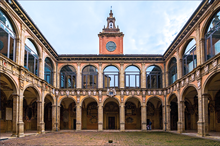
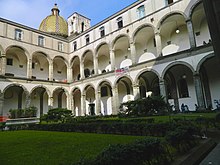
The oldest known institutions of higher education are credited to Dynastic Egypt, with Pr-Anx (houses of life) built as libraries and scriptoriums, containing works on law, architecture, mathematics, and medicine, and involved in the training of "swnw" and "swnwt" (male and female doctors); extant Egyptian papyri from the 3rd millennia BC are in several collections.[22]
In the Greek world, Plato's Academy (c. 387 - 86 BC), Aristotle's Lyceum (c. 334 - 86 BC) and other philosophical-mathematical schools became models for other establishments, particularly in Alexandria of Egypt, under the Ptolemies.
In South Asia, the city of Taxila[when?], later the great Buddhist monastery of Nalanda (c. 427 - 1197 CE), attracted students and professors even from distant regions.[23]
In China, the Han dynasty established chairs to teach the Five Confucean Classics, in the Grand School, Taixue (c. 3 - 1905 CE), to train cadres for the imperial administration.[24][25] All these higher-learning institutions became models for other schools within their sphere of cultural influence.[26]
In 425 CE, the Byzantine emperor Theodosius II innovated as he established the Pandidakterion, with a faculty of 31 professors, to train public servants. In the 7th and 8th centuries, "cathedral schools" were created in Western Europe. Meanwhile, the first Medresahs were founded in the Moslem empire – initially mere primary schools in the premises of major mosques, which gradually evolved toward secondary, later higher education. However high the intellectual level of these schools could be, it would be anachronistic to call them "universities". Their organization and purposes were markedly different from the corporations of students and teachers, independent from both the Church and the State, which established themselves from the 12th century in Western Europe as Universitas Studiorum.[citation needed]
According to UNESCO and Guinness World Records, the University of al-Qarawiyyin in Fez, Morocco is the oldest existing continually operating higher educational institution in the world.[27][28] and is occasionally referred to as the oldest university by scholars.[29] Undoubtedly, there are older institutions of higher education, for example, the University of Ez-Zitouna in Montfleury, Tunis, was first established in 737. The University of Bologna, Italy, founded in 1088, is the world's oldest university in continuous operation,[30][31][32][33][34] and the first university in the sense of a higher-learning and degree-awarding institute, as the word universitas was coined at its foundation.[33][30][31][32]
20th century
Since World War II, developed and many developing countries have increased the participation of the age group who mostly studies higher education from the elite rate, of up to 15 per cent, to the mass rate of 16 to 50 per cent.[35][36] In many developed countries, participation in higher education has continued to increase towards universal or, what Trow later called, open access, where over half of the relevant age group participate in higher education.[37] Higher education is important to national economies, both as an industry, in its own right, and as a source of trained and educated personnel for the rest of the economy. College educated workers have commanded a measurable wage premium and are much less likely to become unemployed than less educated workers.[38][39]
21st century
In recent years, universities have been criticized for permitting or actively encouraging grade inflation.[40][41] Widening participation can increase the supply of graduates in individual fields of study over the demand for their skills, aggravating graduate unemployment, underemployment, overqualification and educational inflation.[42][43] Some commentators have suggested that the impact of the COVID-19 pandemic on education is rapidly making certain aspects of the traditional higher education system obsolete.[44] The involvement and funding by foreign regimes in higher education in the US and Europe raised concerns regarding the erosion of democratic norms and hate speech on campuses.[45][better source needed][46]
Statistics
The total expenditure on tertiary education (ISCED levels 5 to 8) as a percentage of GDP for individual countries is shown in the following table.
| Country | Tertiary Education expenditure as % of GDP 2020[47] |
|---|---|
 Australia Australia | 1.9 |
 Austria Austria | 1.8 |
 Belgium Belgium | 1.6 |
 Bulgaria Bulgaria | 1.2 |
 Canada Canada | 2.4 |
 Chile Chile | 2.7 |
 Colombia Colombia | 1.5 |
 Costa Rica Costa Rica | 1.6 |
 Croatia Croatia | 1.2 |
 Czech Republic Czech Republic | 1.1 |
 Denmark Denmark | 1.9 |
 Estonia Estonia | 1.5 |
 Finland Finland | 1.6 |
 France France | 1.6 |
 Germany Germany | 1.3 |
 Greece Greece | 0.9 |
 Hungary Hungary | 0.9 |
 Iceland Iceland | 1.4 |
 Ireland Ireland | 0.8 |
 Israel Israel | 1.4 |
 Italy Italy | 1.0 |
 Japan Japan | 1.4 |
 Latvia Latvia | 1.4 |
 Lithuania Lithuania | 1.2 |
 Luxembourg Luxembourg | 0.5 |
 Mexico Mexico | 1.2 |
 Netherlands Netherlands | 1.8 |
 New Zealand New Zealand | 1.6 |
 Norway Norway | 2.0 |
 Poland Poland | 1.3 |
 Portugal Portugal | 1.3 |
 Romania Romania | 0.8 |
 Slovakia Slovakia | 1.1 |
 Slovenia Slovenia | 1.2 |
 South Korea South Korea | 1.5 |
 Spain Spain | 1.5 |
 Sweden Sweden | 1.6 |
 Turkey Turkey | 1.5 |
 United Kingdom United Kingdom | 1.5 |
 United States of America United States of America | 2.5 |
The percentage of adults who have attained individual tertiary education levels by country is shown in the following table.
| Country | Ages 25–64: % attaining a tertiary degree course equivalent to at least:[48] | |||
|---|---|---|---|---|
| Any tertiary | Bachelor's | Master's | Doctoral | |
 Argentina Argentina | 24.8 | 1.4 | ||
 Australia Australia | 51.5 | 39.4 | 10.9 | 1.9 |
 Austria Austria | 35.6 | 20.4 | 14.8 | 1.2 |
 Belgium Belgium | 45.8 | 45.0 | 20.1 | 1.1 |
 Brazil Brazil | 21.0 | 21.0 | 1.0 | 0.3 |
 Bulgaria Bulgaria | 29.8 | 29.8 | 20.4 | 0.3 |
 Canada Canada | 62.7 | |||
 Chile Chile | 31.4 | |||
 China China | 18.5 | |||
 Colombia Colombia | 28.3 | |||
 Costa Rica Costa Rica | 25.3 | |||
 Czech Republic Czech Republic | 26.7 | 26.5 | 19.7 | 0.7 |
 Denmark Denmark | 42.1 | 37.0 | 16.3 | 1.5 |
 Estonia Estonia | 42.1 | 36.5 | 21.8 | 0.8 |
 Finland Finland | 42.6 | 35.1 | 17.3 | 1.3 |
 France France | 41.6 | 27.2 | 15.2 | 1.0 |
 Germany Germany | 32.5 | 31.9 | 13.6 | 1.9 |
 Greece Greece | 35.1 | 34.7 | 9.3 | 0.9 |
 Hungary Hungary | 29.4 | 28.5 | 13.9 | 0.5 |
 India India | 12.9 | 12.9 | 3.4 | 3.4 |
 Indonesia Indonesia | 13.1 | 10.3 | 0.8 | 0.0 |
 Iceland Iceland | 43.6 | 39.4 | 18.1 | 1.2 |
 Ireland Ireland | 54.4 | 44.3 | 16.6 | 1.7 |
 Israel Israel | 50.6 | 39.6 | 15.2 | 1.2 |
 Italy Italy | 20.3 | 20.2 | 14.6 | 0.6 |
 Japan Japan | 56.1 | |||
 Latvia Latvia | 39.5 | 35.1 | 18.4 | 0.4 |
 Lithuania Lithuania | 46.5 | 46.5 | 16.5 | 0.8 |
 Luxembourg Luxembourg | 51.5 | 46.6 | 31.4 | 2.9 |
 Mexico Mexico | 20.6 | 20.1 | 1.9 | 0.1 |
 Netherlands Netherlands | 44.7 | 42.4 | 18.2 | 1.2 |
 New Zealand New Zealand | 39.8 | 35.8 | 6.3 | 1.1 |
 Norway Norway | 48.1 | 36.5 | 15.4 | 1.5 |
 Poland Poland | 33.9 | 33.8 | 26.2 | 0.8 |
 Portugal Portugal | 31.5 | 31.2 | 21.7 | 0.9 |
 Romania Romania | 19.7 | |||
 Slovakia Slovakia | 29.2 | 29.1 | 25.3 | 0.9 |
 Slovenia Slovenia | 40.1 | 31.7 | 20.1 | 3.7 |
 South Korea South Korea | 52.8 | |||
 South Africa South Africa | 13.9 | |||
 Spain Spain | 41.1 | 28.5 | 17.2 | 0.8 |
 Sweden Sweden | 48.5 | 38.7 | 18.7 | 2.0 |
 Switzerland Switzerland | 44.7 | 44.7 | 20.0 | 3.2 |
 Turkey Turkey | 25.0 | 18.3 | 2.3 | 0.4 |
 United Kingdom United Kingdom | 51.3 | 42.3 | 15.8 | 1.7 |
 United States of America United States of America | 50.0 | 39.4 | 14.4 | 2.1 |
A 2014 report by the Organisation for Economic Co-operation and Development states that by 2014, 84 percent of young people were completing upper secondary education over their lifetimes, in high-income countries. Tertiary-educated individuals were earning twice as much as median workers. In contrast to historical trends in education, young women were more likely to complete upper secondary education than young men. Additionally, access to education was expanding and growth in the number of people receiving university education was rising sharply. By 2014, close to 40 percent of people aged 25–34 (and around 25 percent of those aged 55–64), were being educated at university.[49]
United Kingdom
Under devolution in the United Kingdom, education is administered separately in England, Wales, Northern Ireland, and Scotland. In England, the term "tertiary education" aligns with the global term "higher education" (i.e. post-18 study).[50] In 2018 the Welsh Government adopted the term "tertiary education" to refer to post-16 education and training in Wales.[51] Since the 1970s, however, specialized further education colleges in England and Wales have called themselves "tertiary colleges" although being part of the secondary education process. These institutions cater for both school leavers and adults, thus combining the main functions of an FE college and a sixth form college.[52] Generally, district councils with such colleges have adopted a tertiary system or structure where a single local institution provides all the 16–19 and adult education, and where schools do not universally offer sixth forms (i.e. schools only serve ages 11–16). However the Further and Higher Education Act 1992 has effectively prevented the creation of new tertiary colleges.[53]
Australia

Within Australia "tertiary education" refers to continuing studies after a student completes secondary school. Tertiary education options include universities, technical and further education (TAFE) or private universities.[54]
United States

The higher education system in the United States is decentralized and regulated independently by each state[55] with accreditors playing a key role in ensuring institutions meet minimum standards. It is large and diverse with institutions that are privately governed and institutions that are owned and operated by state and local governments. Some private institutions are affiliated with religious organizations whereas others are secular with enrollment ranging from a few dozen to tens of thousands of students. The United States Department of Education presents a broad-spectrum view of tertiary education and detailed information on the nation's educational structure, accreditation procedures, and connections to state as well as federal agencies and entities.[56]
The Carnegie Classification of Institutions of Higher Education provides one framework for classifying U.S. colleges and universities in several different ways.[57] US tertiary education also includes various non-profit organizations promoting professional development of individuals in the field of higher education and helping expand awareness of related issues like international student services and complete campus internationalization.[58][59]
European Union
Although tertiary education in the EU includes university, it can differ from country to country.
France
After going to nursery school (French: école maternelle), elementary school (French: école élémentaire), middle school (French: collège), and high school (French: lycée), a student may go to university, but may also stop at that point.
Italy

Education in Italy is compulsory from 6 to 16 years of age,[62] and is divided into five stages: kindergarten (scuola dell'infanzia), primary school (scuola primaria or scuola elementare), lower secondary school (scuola secondaria di primo grado or scuola media inferiore), upper secondary school (scuola secondaria di secondo grado or scuola media superiore) and university (università).[63] Education is free in Italy and free education is available to children of all nationalities who are residents in Italy. Italy has both a private and public education system.[64]
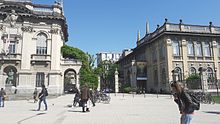

Italy has a large and international network of public or state-affiliated universities and schools offering degrees in higher education. State-run universities of Italy constitute the main percentage of tertiary education in Italy and are managed under the supervision of Italian's Ministry of Education.
Italian universities are among the oldest universities in the world; the University of Bologna (founded in 1088) notably, is the oldest one ever; also, University of Naples Federico II are is the world's oldest state-funded university in continuous operation.[67][68] Most universities in Italy are state-supported. 33 Italian universities were ranked among the world's top 500 in 2019, the third-largest number in Europe after the United Kingdom and Germany.[69]
There are also a number of Superior Graduate Schools (Grandes écoles)[70] or Scuola Superiore Universitaria, offer officially recognized titles, including the Diploma di Perfezionamento equivalent to a Doctorate, Dottorato di Ricerca i.e. Research Doctorate or Doctor Philosophiae i.e. PhD.[71] Some of them also organize courses Master's degree. There are three Superior Graduate Schools with "university status", three institutes with the status of Doctoral Colleges, which function at graduate and post-graduate level. Nine further schools are direct offshoots of the universities (i.e. do not have their own 'university status'). The first one is the Scuola Normale Superiore di Pisa (founded in 1810 by Napoleon as a branch of École Normale Supérieure), taking the model of organization from the famous École Normale Supérieure. These institutions are commonly referred to as "Schools of Excellence" (i.e. "Scuole di Eccellenza").[70][72]
Italy hosts a broad variety of universities, colleges and academies. Founded in 1088, the University of Bologna is likely the oldest in the world.[73] In 2009, the University of Bologna is, according to The Times, the only Italian college in the top 200 World Universities. Milan's Bocconi University has been ranked among the top 20 best business schools in the world by The Wall Street Journal international rankings, especially thanks to its M.B.A. program, which in 2007 placed it no. 17 in the world in terms of graduate recruitment preference by major multinational companies.[74] Bocconi was also ranked by Forbes as the best worldwide in the specific category Value for Money.[75] In May 2008, Bocconi overtook several traditionally top global business schools in the Financial Times Executive education ranking, reaching no. 5 in Europe and no. 15 in the world.[76]
Other top universities and polytechnics are the Università Cattolica del Sacro Cuore in Milan, the LUISS in Rome, the Polytechnic University of Turin, the Politecnico di Milano (which in 2011 was ranked as the 48th best technical university in the world by QS World University Rankings[77]), the University of Rome La Sapienza (which in 2005 was Europe's 33rd best university,[78] and ranks among Europe's 50 and the world's 150 best colleges[79] and in 2013, the Center for World University Rankings ranked the Sapienza University of Rome 62nd in the world and the top in Italy in its World University Rankings.[80]) and the University of Milan (whose research and teaching activities have developed over the years and have received important international recognition). This University is the only Italian member of the League of European Research Universities (LERU), a prestigious group of twenty research-intensive European Universities. It has also been awarded ranking positions such as 1st in Italy and 7th in Europe (The Leiden Ranking – Universiteit Leiden).
Africa
Nigeria

Tertiary education refers to post-secondary education received at universities (government or privately funded), monotechnics, polytechnics and colleges of education. After completing a secondary education, students may enroll in a tertiary institution or acquire a vocational education. Students are required to sit for the Joint Admissions and Matriculation Board Entrance Examination (JAMB) as well as the Secondary School Certificate Examination (SSCE) or General Certificate Examination (GCE) and meet varying cut-off marks to gain admission into a tertiary institution.[81]
Asia
Japan

According to MEXT (Ministry of Education) and UNESCO, following types of education are classified as tertiary education: University education (undergraduate, postgraduate and professional degrees), two-year colleges (Tanki Daigaku), colleges of technology and specialised colleges.[82]
Hong Kong
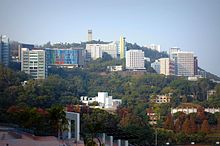
In Hong Kong "tertiary education" or "higher education" refers to any education higher than secondary education. Tertiary education includes universities, post secondary colleges, statutory universities, and publicly funded institutions.
See also
- Category:Higher education by country
- List of countries by tertiary education attainment
- Education by country
- List of higher education associations and alliances
- List of universities and colleges by country
- Student SPILL
- College and university rankings
- Governance in higher education
- Graduation
- Higher education accreditation
- Higher education bubble
- Higher education policy
- Higher Education Price Index
- Institute
- UnCollege
- Hochschule
- League of European Research Universities
- Technical and Further Education (TAFE)
Higher education by country
Notes
References
Sources
- Brick, Jean (2006). "What is academic culture?". Academic Culture: A Student's Guide to Studying at University. Sydney, NSW: National Centre for English Language Teaching and Research. pp. 1–10. ISBN 978-1-74138-135-1.
 This article incorporates text from a free content work. Licensed under CC BY-SA 3.0 IGO. Text taken from #CommitToEducation, 35, UNESCO, UNESCO. UNESCO.
This article incorporates text from a free content work. Licensed under CC BY-SA 3.0 IGO. Text taken from #CommitToEducation, 35, UNESCO, UNESCO. UNESCO.
Further reading
- Alkamel, Mohammed Adulkareem A.; Chouthaiwale, Santosh S.; Yassin, Amr Abdullatif; AlAjmi, Qasim; Albaadany, Hanan Yahia (March 2021). "Online Testing in Higher Education Institutions During the Outbreak of COVID-19: Challenges and Opportunities". In Arpaci, Ibrahim; Al-Emran, Mostafa; Al-Sharafi, Mohammed A.; Marques, Gonçalo (eds.). Emerging Technologies During the Era of COVID-19 Pandemic. Studies in Systems, Decision and Control. Vol. 348. Cham, Switzerland: Springer Nature. pp. 349–363. doi:10.1007/978-3-030-67716-9_22. ISBN 978-3-030-67715-2. PMC 7980164. S2CID 232322223.
- Council of Europe Higher Education Series
External links

